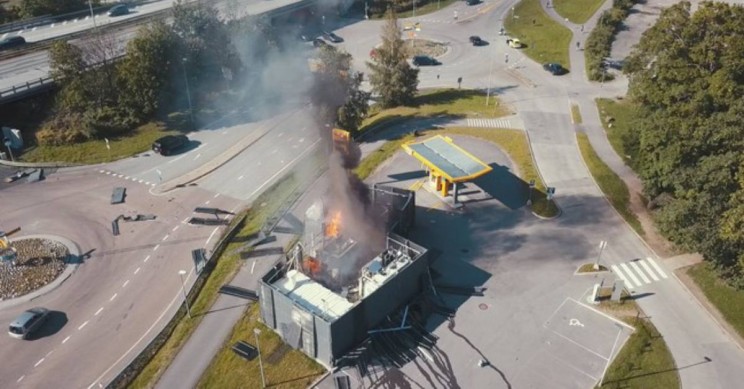Converting excess wind and solar to hydrogen gas is the Federal government’s most ludicrous ‘answer’ to its self-inflicted renewable energy debacle.
The majority of hydrogen available on the market (around 95%) is produced from fossil fuels by steam reforming or partial oxidation of methane and coal gasification with only a tiny fraction produced by way of biomass gasification or the electrolysis of water or solar thermochemistry.
Steam-methane reforming, the current leading technology for producing hydrogen in large quantities, extracts hydrogen from methane, usually in the form of natural gas; the process releases carbon dioxide and carbon monoxide into the atmosphere. Which, of course, doesn’t wash with the climate cult.
Another method of creating hydrogen is electrolysis, which involves chewing up enormous volumes electricity that gets passed through a volume of water to separate the hydrogen and oxygen atoms. The big plus attached to this method is said to be that burning hydrogen gas does not release carbon dioxide gas.
Renewable energy rent seekers have seized on the concept of producing hydrogen gas using wind and solar as a way of converting useless, unpredictable and unreliable electricity into something that can be used as and when consumers need it; rather than something that depends on the whims of mother nature.
If producing industrial volumes of hydrogen using electricity were even vaguely economic, then the obvious way of doing so would be to use coal-fired power; the cheapest and most reliable power source, of all.
But that’s not the point and purpose of the great hydrogen hoax. This is about corporate greed and rent seeking.
The rules of physics (not least thermodynamics) means that, whatever the power source, more energy will be expended than will ever be returned from the process of turning electricity into hydrogen gas, storing and distributing it. Which means it will not result in a net energy benefit.
The storage and distribution of hydrogen gas is not without its challenges. Attempting to contain the gas in large volumes comes with the threat of industrial scale explosions, thanks to its the low ignition point and highly combustible nature, and also because it tends to leak easily from tanks. More than a few hydrogen storage facilities and filling stations have exploded – as to which, see below the image from Norway where one went up with one hell of a bang.
Viv Forbes also points out that the amount of water consumed in the process is not insignificant, particularly in Australia: the driest Continent on Earth.
Not So Green
Saltbush Club
Viv Forbes
11 September 2020
Solar energy is very dilute, so solar collectors usually cover huge areas of flat arable land, stealing farmland, starving wild herbs and grasses of sunlight and creating “Solar Deserts”.
Wind turbines steal energy from winds which often bring moisture from the ocean. These walls of turbines then create rain shadows, producing more rain near the turbines and more droughts down-wind. Turbines work best along ridge lines where eagles also seek thermals, so birds and bats get chopped up by these whirling scythes. They also annoy neighbours with noise and increase bushfire risk.
They even spread their wall of wind towers offshore, so that less wind and rain even reaches the shore. Not green at all.
Then we have the biofuels scandals. This is UN-promoted stupidity where forests are logged in America and shipped across the Atlantic to burn in a British power station; where native forests are cleared in Indonesia and Brazil to grow palm oil for bio-diesel; and where food grains are distilled to make ethanol fuel for motor vehicles. Nothing green about any of this.
Now green dreamers want to use our precious water to manufacture hydrogen in a round-robin electrolytic process that consumes far more energy than it can ever produce.
Electrolysis consumes nine tonnes of water plus heaps of electricity to make one tonne of hydrogen. This processed water is not recovered until the hydrogen is burned (unlike water in steam turbines where most water is reused and some escapes to the atmosphere via cooling towers.)
“In the beginning, there was nothing, which exploded.” Terry Pratchett
Hydrogen is a low-energy explosive gas. Collecting, storing and exporting it will be a hazardous business and producing it will consume scads of Australian water and electricity to generate trendy “green” fuel for Asia. Burning this fuel will release pure Australian water into polluted Asian skies. But the Australian Government is funding hydrogen speculation with $70 million.
Green Energy isn’t green. It has a huge cost in rare metals; it creates toxic waste problems; solar panels create solar deserts; turbines chop birds and steal wind and rain from inland areas; and now they want to steal fresh water and energy to export low-energy explosive hydrogen.
In contrast, coal is fossil sunshine. Burning it releases new energy for industry and its combustion products bring great benefits for the green world – water vapour, carbon dioxide plant food, and valuable plant micro-nutrients.
Why export our sunshine, wind and fresh water via hydrogen while leaving our abundant fossil sunshine locked underground as “politically stranded assets”?
All that is not green – it’s green stupidity.
Saltbush Club


